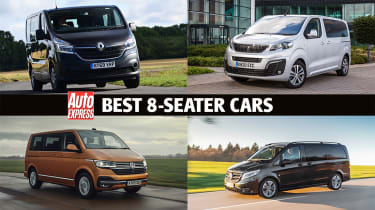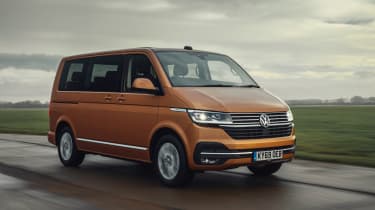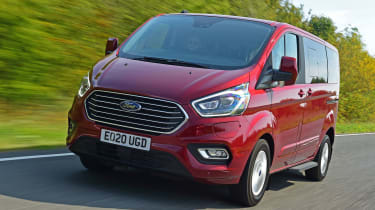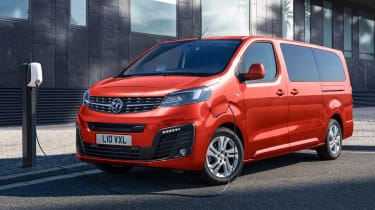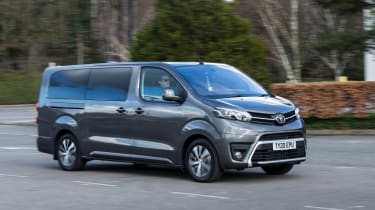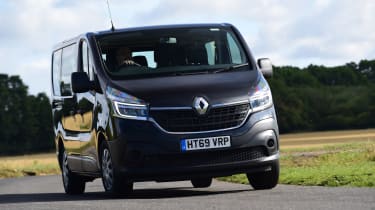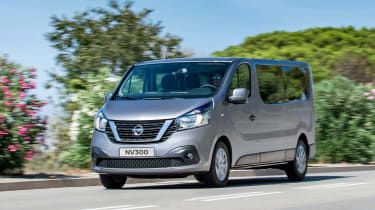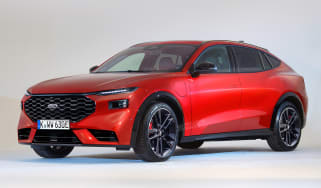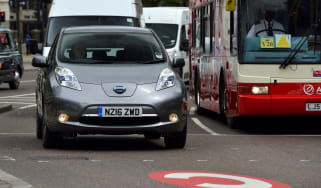Best 8-seater cars to buy
Is an eight seater what your family needs? Here is a list of the vans that go where MPVs can't reach
Should you have a big family, and need at least eight seats, it can be a bit of a struggle to find a suitable car. If there are only three, four or five people in your household then you can’t move for options. Even bigger families are well catered for by assorted seven-seat MPVs (Ford S-MAX/Citroen Grand C4 Picasso) and SUVs (Kia Sorento/Volvo XC90). But if your family is bigger than that the options diminish quite quickly. If you need an 8-seater car, that's where the van-based people carriers come in.
In the past, these van-based models have demanded plenty of compromise in terms of driving dynamics and luxury. But today's vans are stepping up in terms of the kind of kit they offer and the way they drive. Their interiors are also becoming well trimmed with carpet throughout and plenty of plastic cladding to cover up the metal bodies beneath.
There's still not much in the way of style with today’s 8-seat options but the more expensive executive shuttle-style models can feel pretty plush inside, if you can afford one on your family’s budget. With their large, boxy bodies and huge windows, these vehicles can still feel spacious when you're driving with a full load of passengers on board.
Another great advantage of the van-based people carrier is the seating flexibility on offer. In most van-based people carriers, the front two chairs will be fixed, but the second and third rows should offer a versatile range of seating layouts, from two rows of three-abreast seats, to facing seats with the rearmost row pushed all the way back. As well as being able to rearrange them, stronger owners will also be able to remove them completely to turn the people carrier back into a van - although you will need somewhere to store the seats when they're not in use.
Van-based people carriers can be large, as they're normally based on mid-sized vans. But as they come with sliding side doors, access in tight spots is straightforward. To help with parking, most come with either a reversing camera or parking sensors, although sometimes these are optional rather than standard.
So which 8-seater van-based people carrier is the best? Here's the Auto Express top-nine...
1. Volkswagen Transporter Shuttle / Caravelle
Volkswagen’s success with large practical people movers goes all the way back to its iconic (but very basic) T1 campervan. Today things are much more high-tech, with the German carmaker’s latest-generation Transporter (aka the T6.1) being available with mod-cons such as a touchscreen infotainment system and Bluetooth.
In some respects, things have not changed all that much from the original, though. For example, there is still a wide variety of body styles to choose from. Those in need of eight seats or more don’t just have one version of the Transporter to select from either – there are Transporter Shuttle and Caravelle variants with long and short wheelbases options of both. There are also California campervan models which can come with five, six or seven seats.
Transporter Shuttle models are focused on moving people about in comfort at a reasonable price, but they are by no means lacking in equipment and refinement. Caravelle versions are definitely the more upmarket choice, but then again, they are more expensive. All Shuttle and Caravelle variants come with a two-litre diesel engine although power output ranges from around 150bhp to 200bhp. Both automatic and manual gearboxes are available and four-wheel-drive is an option for Caravelle models. Something for everyone, perhaps.
2. Ford Tourneo Custom
The Tourneo Custom is a good-looking, spacious vehicle with plenty of equipment and has over 30 possible seat configurations. Based on the platform of the excellent Transit Custom, it’s one of the best van-based people carriers on the market to drive. With good brakes, sharp steering and a torque vectoring system that helps make best use of its power in corners, it really does have car-like driving qualities.
Back in 2017, Ford treated its Tourneo Custom range to a full mid-life facelift although the changes didn’t come into effect until 2018. The most major improvements were aligning front-end styling to Ford’s passenger cars and on higher-spec Tourneo Customs, the latest infotainment system. The option of a short wheelbase or a long wheelbase remained.
Prices start from around around £39,000 for Shuttle Bus specification which comes with twin sliding doors, nine seats, heated folding mirrors and front and rear parking sensors. As a note, the ninth seat is more of a token as it is located between the driver and front passenger. Other specs include Zetec, Titanium, Active (which adds SUV-inspired styling such as wheel arch cladding), Titanium X and Sport. The most expensive Tourneo Custom models are plug-in hybrids which are priced at just over £62,000 and only come in Titanium trim.
3. Vauxhall Vivaro Life
Considering the Vauxhall Vivaro Life is a relative newcomer to the uber-practical people carrier market, it is a very convincing effort from the Peugeot-Citroen owned brand. Saying that, the Vivaro shares a platform with other cars from Citroen and Peugeot so it is somewhat tried and tested.
Traditionally fuelled models use either a 1.5-litre diesel engine or one of two 2.0-litre diesel engines. While the latter units are the most powerful (one comes with 148bhp and the other 178) it is the former which is the more frugal, but it only produces around 120bhp. There is also a battery-powered Vivaro-e Life which is claimed to have a range of 143 miles. When plugged into a 100kW power supply, the Vivaro-e Life is said to be capable of going from zero to 80 per cent charge in 30 mins.
As for standard equipment, niceties such as a seven-inch touchscreen infotainment display, air-conditioning and Bluetooth are included across the range – which constitutes Edition and Elite trims only. Out of the box, all Vivaro Lifes come with five seats but a third row is available as a no-cost option, which puts the seat count up to eight. Like many large people movers, there is a choice of two wheelbases – medium and long. The difference is 350mm or just over one foot.
The SpaceTourer arrived in the UK back in 2016 and very quickly established itself as one of the best van-based people carriers. That boxy body is built on the same platform as the Citroen C4 Picasso, but the larger dimensions mean there's room inside for eight seats and space for luggage, too.
There are three specifications to choose from; Business, Feel and Flair. The latter two will be familiar to anyone au fait with Citroen’s passenger range of cars but the former is pitched as more of a corporate-friendly spec. There are also M and XL body styles to choose from – the difference being overall length. Prices start from around £37,000 for diesel models and around £50,000 for an electric SpaceTourer.
There are three diesel engines to choose from and one fully-electric model. The BlueHDi diesel engines deliver decent power and efficiency in the SpaceTourer while the electric e-SpaceTourer is claimed to be capable of up to 143 miles on a full charge. On the road, the SpaceTourer handles pretty well for a van, as it's car-based platform delivers good grip and sharp handling. One minor downside is that the car's overall width is down on some of its van-based rivals, so shoulder space in the three-abreast seating can be a bit tight.
The Peugeot Traveller is the sister car to the Citroen Space Tourer, Vauxhall Vivaro Life and Toyota Proace Verso, and is largely identical in its layout, configuration and the powertrains it offers. The big difference, of course, is the Peugeot lion on the nose, and it's arguable that the Traveller isn't quite as handsome as its Citroen-badged sibling.
As with the Citroen, Vauxhall and Toyota, the Peugeot is based on the EMP platform that's used for all manner of other cars, including the 308 hatchback and 3008 crossover. That means this is a van that handles as well as a car, and while it doesn't have quite as much interior space as other van-based people carriers from Renault and VW, it makes up for this with a better driving experience.
As for engines, the 1.5-litre Blue HDi unit in 120 guise, plus the 2.0-litre BlueHDi engine in 150 and 180 forms are available, along with a six-speed manual transmission or an eight-speed auto. Plus, a battery-powered e-Traveller has joined the ranks. Prices are similar to the other models in the family, starting at around £37,000 and stopping at just over £54,000.
There are two body lengths - Standard and Long. Also, the back seats are removable, although the seats are in a 2:1 configuration, and the two seats are quite heavy to remove and put back in place.
6. Toyota Proace Verso
The fourth part of the Peugeot/Citroen/Vauxhall/Toyota van party is the Proace Verso. Toyota has simply grafted its own pointy nose on the same body as the Traveller, SpaceTourer and Vivaro, while tacking the Verso name on the end of Proace tells you where this van-based people carrier's roots lie.
There are two body lengths available (there used to be three, but the shortest “Compact” version was dropped) in combination with the 1.5-litre (118bhp) and 2.0-litre (148bhp/178bhp) diesel engines. Toyota includes a variety of trims, starting with basic Combi, then passenger-friendly Shuttle, then more upmarket Family. At the top of the tree is VIP, which is the range’s executive variant and comes as standard with an automatic gearbox.
Just like its siblings, the Proace Verso has plenty of space and handles pretty well for a van-based people carrier.
7. Mercedes Vito Tourer
The Vito is a hugely practical vehicle that's a more utilitarian variant of the luxurious V-Class from the Mercedes passenger car range. As standard, it comes with nine seats and space for luggage. The latter changes depending on the length of Vito Tourer, of which there are three options – L1, L2 and L3. L1 models are about 4.9 metres long, L2 around 5.1 and L3 roughly 5.4.
The four available engines are refined, while the van-based people carrier manages to deliver car-like handling. Entry-level models are basic and prices soar as you ascend the range. The most affordable Vito Tourer costs around £32,000 and range-toppers come in at in excess of £52,000.
The pick of the engine range for fuel economy is the 134bhp 2.0-litre 114 Tourer diesel, in short-wheelbase form, which returns 39.8mpg on the combined cycle (under WLTP conditions) and has emissions of 186g/km. Along with the range of engines, there are both manual or automatic gearboxes and front- or rear-wheel-drive available.
Trim levels are Pro, Select and Sport. Pro level has steel wheels, electrically heated and adjustable door mirrors, a leather-trimmed steering wheel and rear privacy glass. Select adds 17-inch alloy wheels, a seven-inch touchscreen infotainment system, Apple CarPlay/Android Auto, cruise control and automatic wipers. Top-of-the-range Sport includes 17-inch alloy wheels, multifunction steering wheel, sportier styling, parking assist (effectively self-parking), rear air-conditioning and satellite navigation.
8. Renault Trafic Passenger
Developed on the same platform as the Nissan NV300 Combi, the Trafic Passenger is another “best eight-seater” that actually has nine seats. Like others, this ninth seat is part of the front row, so it can be uncomfortable especially in models with a manual gearbox. Renault refreshed its Trafic Passenger in 2019 ahead of a more thoroughly revised version arriving in 2021. The headline changes for 2021 are set to include a subtle exterior redesign and a new dashboard taken from the latest generation of Clio.
The Trafic Passenger is offered with three versions of Renault’s 2.0-litre dCi diesel engine, along with manual and automatic transmissions. There are three trims – Business, Sport and SpaceClass – and two body lengths to choose from. Prices start from £35,000 and go all the way up to just over £50,000.
Business trim gets electrically adjustable door mirrors, LED headlights, DAB radio, Bluetooth and a USB socket and unlike many vans, there is a rear parcel shelf. Sport trim gets air-conditioning, leather steering wheel, automatic lights and wipers, rear parking sensors and cruise control. SpaceClass adds additional heating for rear passengers, extra tinted windows and various gloss black trim pieces.
9. Nissan NV300 Combi
The NV300 Combi uses the same platform as Renault’s Trafic Passenger. Ignoring manufacturer badges the similarities between the two sister models are very obvious. From a short distance away many would not be able to tell the two apart. It is a similar story inside, too.
There’s one engine available, a 1.6-litre diesel, although there is a choice of four power outputs. The least powerful model produces 94bhp and the most powerful 143bhp – the middle two are rated at 118bhp and 123bhp. Currently, Nissan only offers a manual gearbox so those wanting an auto will need to look elsewhere.
It is the 123bhp models that promise to be the most economical, with their official fuel consumption claimed to be 50.4mpg. For the same engine, CO2 emissions are stated to be 145g/km. One of Nissan’s biggest selling points is its long warranty. The Japanese carmaker covers its models for five years or 100,000 miles (whichever comes first). The NV300 doesn’t disgrace itself out on the open road, either – visibility is good and twists and turns are handled well.
Now read about the best used MPVs and people carriers...
